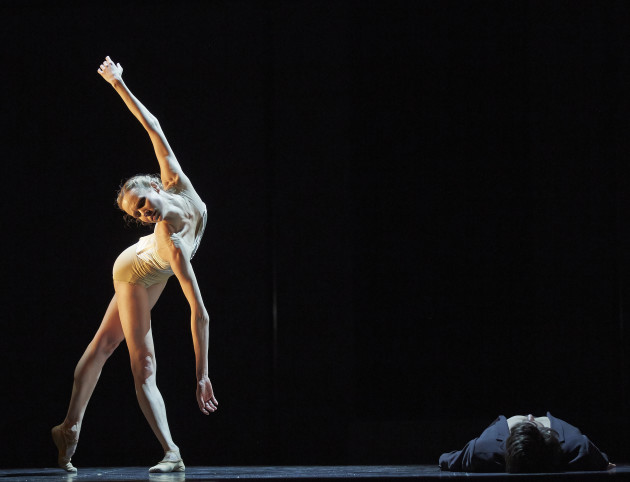West Australian Ballet:
Romeo and Juliet, His Majesty's Theatre, Friday 9 September
Radio & Juliet, His Majesty's Theatre, Wednesday 14 September
To honour the 400th anniversary of William Shakespeare's death, West Australian Ballet's artistic director Aurélien Scannella programmed a "double-season" of two very different artistic responses to Shakespeare's Romeo and Juliet. Hungarian-born choreographer Youri Vámos's Romeo and Juliet (ch.1999) and Romanian Edward Clug's Radio and Juliet (ch. 2005) are popular, absorbing works already in the company's repertoire. Both ballets are an ideal fit for the diverse and versatile dancers of West Australian Ballet (WAB) and were performed on alternate days for this season, giving audiences an option to attend either production or both.
Choreographed to the much-lauded Sergei Prokofiev score composed in the 1930s, Vámos's Romeo and Juliet is set in this period in Shakespeare's original location, Verona in Italy.
With strategic and dramatically effective staging, and clear, absorbing story-telling in short scenes, Vámos expertly captures the emotional heart of the story. Michael Scott's attractive, minimalist set is a winner, with curtained arches surrounding the stage used for entrances and exits and sleight-of-hand passing of props, although a far-from-minimalist large black car 'driven' across the stage is also a knockout. His stylish 1930s costumes are a delight and lighting-designer Klaus Garditz’s attractive tones and specials enhance all of this.
On opening night, Australian-born international conductor Nigel Gaynor brilliantly guided the West Australian Symphony Orchestra through the nuances, ebb and flow of Prokofiev's grand, impassioned score, producing a thrilling and profound sound while elevating the impact of the drama and tragedy on stage.

Soloist Gakuro Matsui made an outstanding debut with WAB as a very youthful, gentle and vulnerable Romeo. His silky, lyrical technique, exceptional ballon and sensitive partnering were well matched with Sarah Hepburn's admirable, believable performance as a playful, impetuous Juliet. Andre Santos (Mercutio) lit up the stage whenever he was on it. He danced brilliantly and handled the comic, dramatic and tragic elements of the role superbly. Alessio Scognamiglio (Benvolio) danced strongly throughout and gave a fine interpretation and Matthew Lehmann (Tybalt), always an authoritative force on stage, was a compelling, threatening presence. Christopher Hill (Paris) found expansive movement and control in his solo and was convincing as a proud, reserved man. Young artist Ari Thompson (Friar Lorenzo) tellingly revealed the friar's conflicted conscience, and Craig Lord-Sole (Lord Capulet) was prominent as Juliet's stern father given to rage and callousness.
Among many sparkling scenes are Romeo, Mercutio and Benvolio's antics in their novelty disguises, the lively vagabonds (Matthew Edwardson, Meg Parry, Chihiro Nomura, and Carina Roberts an eye-catching 'boy'), festive ensemble dancing on the street, and eight dazzling couples in black carving up the space at the ball.
Vámos's modernist, classically-based choreography effectively incorporates angular shapes and unusual use of hands and arms juxtaposed to graceful lines, although some of the more awkward transitions seem unwarranted. Welcome parallels to West Side Story are apparent in the early gang brawls between the Montagues and Capulets.
Ending the ballet with the young lovers' tragic deaths on stage diverges from Shakespeare's play, which concludes with the deaths a catalyst for reconciliation between the families. However in Vámos's version, in an inspired addition, Juliet wakens as Romeo, having taken poison thinking she has died, is near death. A final tender pas de deux gives them precious moments together before he dies and distraught Juliet ends her life.
Radio and Juliet, choreographer Edward Clug's very contemporary response to the traditional story, begins almost where Vámos's Romeo and Juliet ends, but before Juliet dies. This sets up a 'what if Juliet chose to live?' scenario which is explored through a deconstruction of events in the story involving the men in her life, and told in flashbacks.
Original lighting by Clug includes unexpected blackouts imaginatively used to divide the scenes. Modernistic costumes by Leo Kulas, and Marko Japelj's simple set of five, lit, multi-use panels create a streamlined, versatile space. Grainy, distorted black and white filmed sections add atmosphere but are puzzling.
Black drapes and the theatre's proscenium arch frame the stage and direct focus onto the seven exceptional dancers (Brooke Widdison-Jacobs, Matthew Lehmann, Christopher Hill, Alessio Scognamiglio, Christian Luck, Oliver Edwardson and Liam Green), in a concentrated hour of fascinating, top quality dance-drama.
Ten of Radiohead's recorded songs provide the robust, resonant and visceral soundscape underpinning this production. Clug's distinctive and very demanding choreography is rapid, articulated, unconventional and athletic. Ferocious, gripping fight sequences for the men and several intricate, synchronised sections are standouts.
In a stunning performance, Widdison-Jacobs more than met the choreographic and dramatic complexities of her role and she and Lehmann (in another terrific performance) were compelling together. Clug's Radio and Juliet ends where it begins after an ultimate, yet optimistic, twist; this Juliet chooses life.
The enthusiastic, rousing audience response to both these works was very well deserved.
- Margaret Mercer



